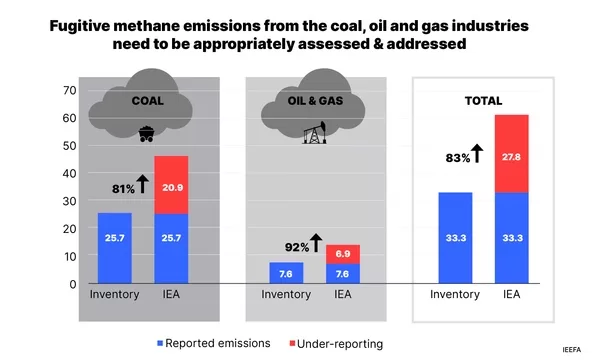Fugitive emissions of methane in Australia are far higher than reported, meaning industry efforts to meet the country’s net zero targets may need to be significantly recalibrated, according to a new report.
The International Energy Agency (IEA) recently published estimates of actual methane emissions by country for 2022, including emissions detected by satellites.
The IEA estimates that methane emissions from coal mining in Australia are about 81% higher than the national inventory data, and for oil and gas sector, 92% higher.
The report was released on the same day that the NSW Land and Environment Court ruled the Independent Planning Commission’s approval of Whitehaven Coal’s expansion of their Narrabri Coal Mine was legally reasonable even though the project will emit the equivalent of Australia’s total annual CO2 emissions.

IEA estimates actual emissions far exceed government estimates, putting industrial facilities under pressure
Although it has a shorter life in the atmosphere, methane is a far more damaging greenhouse gas than carbon dioxide. This is because it absorbs much more energy than CO2 while it exists in the atmosphere – warming 82 times more than CO2 over a 20-year period.
“According to the IEA estimates, Australia is currently omitting 28 million tonnes of CO2 equivalent (MtCO2e) of fugitive methane emissions from its inventory, which is about 6% of its total emissions,”
says author Amandine Denis-Ryan, chief executive of IEEFA Australia.
Under-reporting of fugitive methane emissions has massive implications for industry & government
The IEA data means major industrial emitters covered by the federal government’s Safeguard Mechanism would have to more than double their emissions reductions by 2030.
Amandine Denis-Ryan, chief executive of the IEEFA & author of the report, said the under-reporting means the emissions targets under the federal government’s Safeguard Mechanism would need to nearly double from cuts of 4.9% to 9.8% a year.
“It is critical to correct these underestimates as soon as possible, in particular in the context of the declining cap set on Australia’s largest industrial emitters as part of the Safeguard Mechanism”
“The under-reporting will have a very material impact on the Safeguard Mechanism baseline declines. Based on our calculations, the baseline decline rate would need to be doubled from 4.9% to 9.8% a year for covered facilities.
This would require covered facilities to more than halve their emissions over a period of seven years.”
Ms Denis-Ryan says.
The only alternative would be to increase emission reduction requirements from other sectors of the economy.
With such strong implications, it is critical that methane emissions under-reporting is corrected as soon as possible, and that a plan is developed to address those emissions to ensure that Australian industries and households do not bear the brunt of the cost for the methane emissions by the coal, oil and gas industries.
For example, the United States introduced a new waste emissions charge for methane emissions from the oil and gas industry equivalent to A$45 per tonne of CO2 equivalent in 2024, A$60/tCO2e in 2025, and A$76/tCO2e in 2026 onwards.
Double the rate of decarbonisation and halve the emissions
In order to stay within the newly introduced emissions caps, facilities would have to double their rate of decarbonisation and halve their emissions between 2023 and 2030.
This highlights the need for urgent action to improve methane emissions monitoring in Australia and to develop a plan to address domestic methane emissions.
We need urgent action to improve methane emissions monitoring and reduction, to ensure Australia’s industry and households do not pay for the gross under-reporting of emissions
by the coal, oil and gas industries.
Australia’s response to the climate crisis and gas industry emissions is influenced by the Climate Change Authority with former Managing Director of Origin Energy, Grant King & Susie Smith from Santos on the board.
Larry Marshall as head of the CSIRO saw many climate scientists leaving that organisation while the CSIRO’s GISERA (Gas Industry Social and Environmental Research Alliance) monitoring of fugitive methane emissions relies solely on the gas industry self-reporting data.
Correcting this under-reporting means large industrial facilities would have to double their rate of decarbonisation and halve their emissions by 2030.
The International Energy Agency (IEA) recently published estimates of actual methane emissions by country for 2022. These estimates are based on “all publicly reported, credible sources where data has become available”, which includes emissions detected by satellites. We compared those estimates to the latest official national emissions inventory figures.
The Institute for Energy Economics and Financial Analysis (IEEFA) examines issues related to energy markets, trends, and policies. The Institute’s mission is to accelerate the transition to a diverse, sustainable and profitable energy economy. (ieefa.org)
Related stories
Our coverage of the Gas Industry includes Meet the Frackers: Gas explorers in Australia



